Contents
The Urals for gardeners is a region of “risky farming”, climatic and weather factors here are clearly not favorable to them. Therefore, for planting, you need to choose zoned varieties and hybrids that are specially adapted to the local climate. This applies to any crops, including the Krasnobokaya pear, recognized as one of the most successful achievements of the Ural breeders.
History of breeding
Pear Krasnobokaya – a variety created in the Ural branch of the Academy of Sciences. The originator is FGBNU “Ural Agricultural Research Center”. The work of a team of breeders began in the mid-70s of the last century, the stability of varietal characteristics was achieved only in the early 90s. “Parents” were varieties Tenderness and Zheltoplodnaya.
An application for registration of a pear called “Red-sided” was filed in 1992. The variety was included in the State Register of Breeding Achievements only ten years later.
Description of the Red-sided pear with a photo
Externally, the tree practically does not differ from the “relatives”. However, the variety immediately stands out for its presentability and large fruit size.
Tree
Red-sided pear is a tree of medium height (up to 4 m). Growth rates immediately after planting are quite high, after the first fruiting they slow down sharply. The crown of the correct rounded shape, sparse. The leaves are large, with a pronounced corrugated surface.
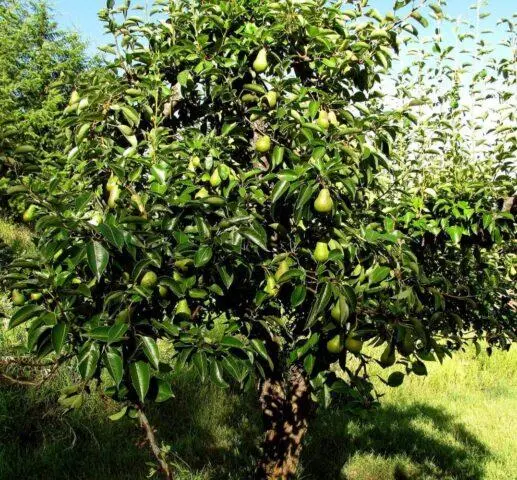
Most of the branches of the tree are noticeably curved, they depart from the trunk at an angle close to a straight line.
Fruit
The fruits of the Red-sided classic pear-shaped, unusually large for the Urals (weighing 150-180 g). One-dimensionality and symmetry add to their presentability.
The shade of the peel of unripe fruits is light green. As they ripen, it changes to greenish-yellow. In those places where the sun’s rays fall on the fruits, blurry spots of a pinkish or raspberry “blush” of varying degrees of intensity appear.

The skin is thin and tender, almost not felt when eating
The flesh is tender and “oily” in texture, despite the presence of a pronounced “grain” on the cut. The hue varies from almost white to yellowish cream.
Characteristics of the red-sided pear
One of the main varietal characteristics of the Krasnoboka pear, which distinguishes it from among the “relatives” and has a great influence on the choice of gardeners, is the taste of the fruit. But before landing, you need to familiarize yourself with its other properties.
Tasting assessment of pear Krasnobokaya
In terms of taste, the Krasnobokaya pear may well compete with other varieties and hybrids that are more picky about the climatic conditions in the region of cultivation. The pulp is pronouncedly sweet, with a slight “balancing” sourness, without which it would seem “fresh”, and almost imperceptible astringency.
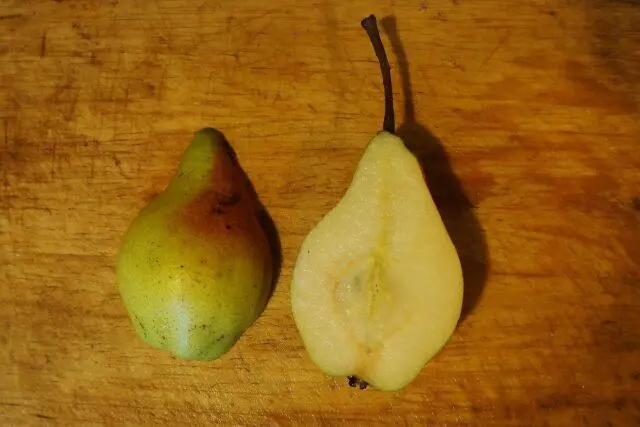
A pronounced pear aroma is preserved after heat treatment in any homemade preparations and wines.
Terms of maturation
Contrary to popular belief, Krasnobokaya is not a winter, but a late autumn pear variety. It is removed from the tree slightly unripe because the ripe fruits quickly fall off, and not so that the fruits gradually ripen by December-January.
Productivity
The yield of the Krasnobokaya pear, demonstrated during official variety tests, is 105 centners per hectare. According to this criterion, it almost 1,5 times surpassed the variety chosen as the “control”.
The tree enters fruiting 5-7 years after planting in open ground. He does not have “rest” seasons; crops are harvested annually. On average, an amateur gardener can count on 30-40 kg of fruit from an adult (over ten years old) tree.
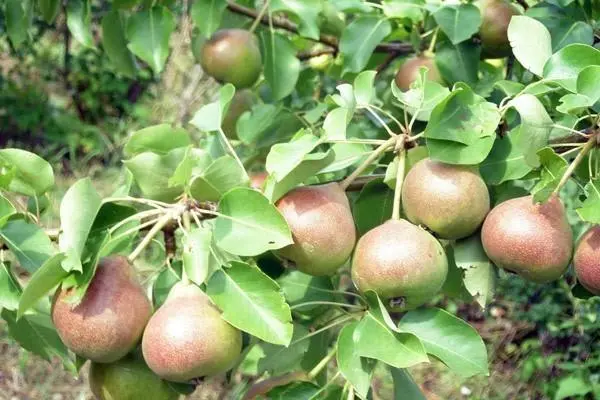
Often, the harvest of the Krasnoboka pear has to be rationed by removing the least well-located ovaries.
Frost resistance of pear Krasnobokaya
According to official data, the cold resistance of the Krasnoboka pear varies between -30-35 ° C. However, according to the information of the originator, in the process of working on a new variety, the seedlings fell under frosts below 45 ° C and successfully survived them, suffering little damage and quickly recovering. And this allows us to consider the Krasnobokay pear as practically a “record holder” for this indicator.
Pollinators of the red-sided pear
Officially, this variety is not among the self-infertile. However, without “outside help” harvests will be extremely meager. Pollinators are chosen based on the same timing of flowering and their ability to survive in the local climate. Most often, next to Krasnoboka, gardeners plant varieties Severyanka, Myth, Hanging (3-4 trees in total).
Growing regions
According to the description of the variety given in the State Register of the Federation, the Krasnobokaya pear is recognized as the most suitable for cultivation in the Urals. However, the experiments and experiences of gardeners quickly proved that its “habitat” can be greatly expanded to include both Siberia and the Far East, as well as regions with a more favorable temperate climate for gardening.
Interested in the variety and in the near abroad. As a result, the Krasnobokaya pear quickly and successfully “migrated” to the territory of Belarus, Kazakhstan, and Ukraine. It is also found in the Baltics.
Disease resistance
The general hardiness needed for the Krasnobokaya pear to “survive” in the harsh Ural climate includes good resistance to diseases and pests. According to the originator, she rarely suffers from scab and gall mites.
Gardeners practically do not note cases of crop damage by powdery mildew and cytosporosis. Also, aphids, pear codling moth, leafworm, butterfly caterpillars that feed on leaves do not show much interest in it.
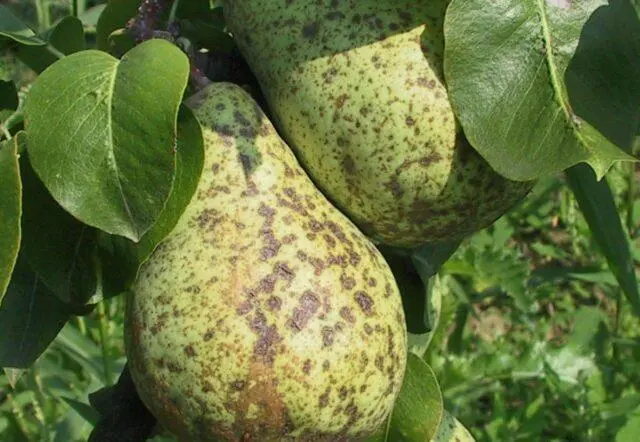
Scab is one of the most dangerous diseases for pears; fruits affected by the fungus are unsuitable for food
Advantages and disadvantages
The Krasnobokaya pear stands out for its powerful and well-developed root system. Accordingly, it is impossible to thicken the landings.
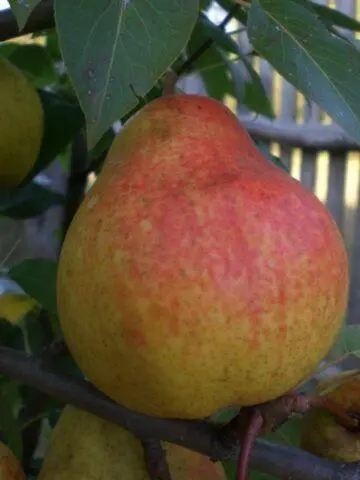
The Red-sided pear is distinguished not only by its annual fruiting; weather during spring and summer has little effect on yield
Pros:
- general hardiness sufficient to adapt to the harsh Ural climate, including almost record frost resistance;
- high resistance to many typical crop diseases and pests;
- ease of maintenance;
- annual fruiting without “breaks”;
- stable high yield;
- external presentability and outstanding taste of fruits;
- versatility of the “culinary” purpose of pears;
- the relatively small height of the tree, the sparseness of the crown (both of which facilitate the care of it and the harvesting process).
Cons:
- slight astringency in taste, much more noticeable in unripe fruits;
- often found small hard “lumps” in the pulp;
- the inability of fully ripe fruits to “hold” on the branches;
- short shelf life of fruits.
Planting a red-sided pear
The Krasnobokaya pear in the regions where it is most common is planted in the spring (in the second half of May or even in early June). It is necessary to wait until the soil warms up sufficiently, and the likelihood of returning frosts is minimized.
A landing site is chosen based on several criteria:
- good illumination, no dense shadow (minimum distance of 3 m from any obstacle);
- the presence of protection against sudden gusts of wind, cold drafts;
- groundwater lying a meter or more below ground level;
- a substrate that combines fertility and looseness (chernozem, forest gray soil, sandy loam, loam).
The least suitable place for planting a Red-sided pear will be any lowland or section of the slope closer to the foot of the hill. There, the substrate is almost always waterlogged due to long-term stagnant melt and rainwater. Accumulates in the lowlands and cold damp air.
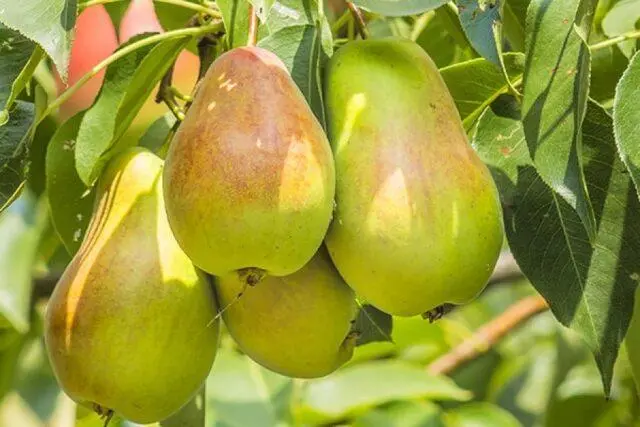
When planting in the shade, you can not count on a good harvest of pears of the Krasnobokaya variety
The planting of the Red-sided pear takes place according to the algorithm standard for a seedling of any fruit and berry crop, including subsequent mulching and pruning. The approximate dimensions of the landing pit are 70-80 cm in depth and in diameter. A drainage layer is required at the bottom, then fertile soil, it needs to fill about a third of the total volume of the pit.
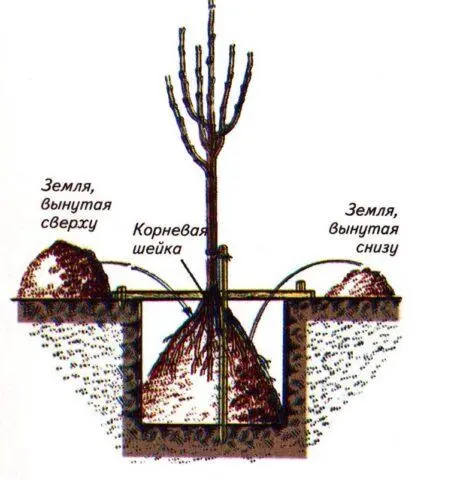
A pit for spring planting of the Krasnoboka pear needs to be prepared last season, in the fall
Pear Care
Pear Krasnobokaya requires only standard care measures:
- Watering. In the first season after planting, the substrate in the trunk circle should not be allowed to dry out. Saplings are watered every 10-14 days, taking into account the volume and intensity of natural precipitation. The approximate consumption rate is 10 liters per plant. An adult pear is regularly watered only in extreme heat and drought, and in addition – three times a season – before, after flowering and around the end of October.
- Top dressing. Fertilizers are applied according to the standard scheme. In the spring, shortly after the “awakening”, the Krasnoboka pear needs nitrogen, during flowering and the formation of fruit ovaries – complex top dressing. In autumn, in preparation for winter, phosphorus and potassium must be added.
- Pruning. For the Red-sided pear, a sparse-tiered crown with 3-4 tiers of skeletal shoots and branches of the 2nd-3rd order on them is best suited. When such a configuration is fully formed (it takes 3-4 seasons), you can limit yourself to maintaining it and sanitary pruning – the crown of the tree is sparse, it grows slowly.
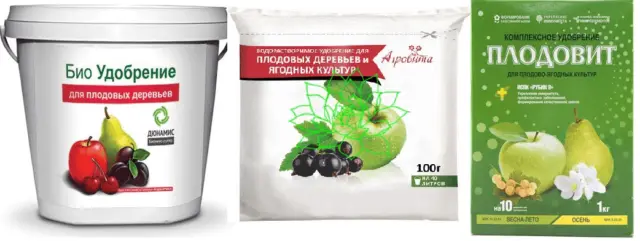
Due to the high yield and annual fruiting, it is advisable to use complex store preparations for top dressing.
Collection and storage
The Red-sided pear is removed from the trees in a slightly unripe form in the last decade of September or early October. It is impossible to delay harvesting – ripe fruits quickly crumble to the ground, their keeping quality suffers greatly.
The red-sided pear is stored for a short time – a maximum of three months. If the conditions are far from optimal, the “shelf life” is reduced to 20-30 days. The fruits are folded into any container that provides air exchange, stored in a dark room with a temperature of 5-7 ° C and good ventilation.
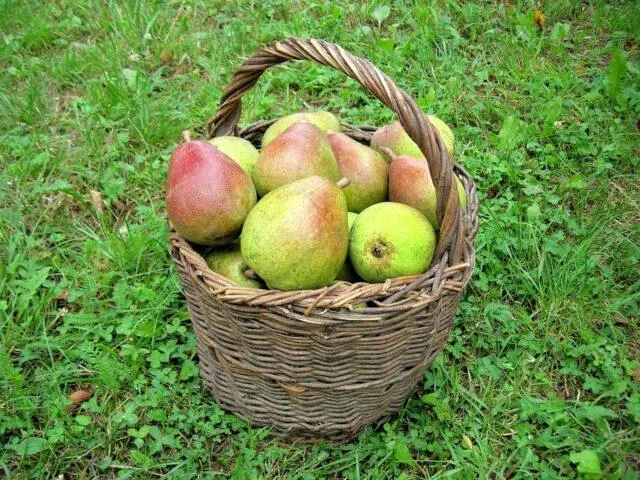
Regarding the shelf life of Krasnobokaya pears, the information in the reviews of gardeners with experience in growing it varies greatly.
Conclusion
Pear Krasnobokaya was originally intended for cultivation in the Urals, but successfully “taken root” in many other regions, on the territory of the former Soviet republics. Ease of care, stable and fairly high yields, presentability and taste of fruits, good immunity contribute to its steady popularity. Of course, the variety is not without certain disadvantages, but, according to most gardeners, its advantages definitely outweigh it.










